霉菌毒素黄曲霉毒素 B1、脱氧雪腐镰刀菌烯醇和玉米赤霉烯酮对家蚕幼虫存活率、生物量和毒素积累的影响
IF 2.2
4区 医学
Q3 FOOD SCIENCE & TECHNOLOGY
引用次数: 0
摘要
昆虫作为饲料和/或食品生产的一种可能成分,正受到越来越多的关注。如果得到有效利用,昆虫可以为全球粮食安全做出可持续的、经济上有利的贡献。家蝇幼虫(HFL)可以在各种有机副流上生长,并通过部分转化为优质蛋白质来提升它们的品质。有机副溪流可能受到天然毒素(如霉菌毒素)的化学污染,因此应研究其对昆虫存活率和生物量的影响以及其他饲料和/或食品安全问题。在这项研究中,将 HFL 暴露于添加了黄曲霉毒素 B1 (AFB1)、脱氧雪腐镰刀菌烯醇 (DON) 或玉米赤霉烯酮 (ZEN) 的饲料基质中,其浓度是欧盟委员会为饲料原料设定的最高浓度或指导值的 1 或 10 倍。记录暴露五天内 HFL 的死亡率和生物量。采用 LC-MS/MS 分析法确定提供的底物、幼虫和残留饲料中霉菌毒素的浓度。通过计算摩尔质量平衡,可以估算出幼虫体内和残余饲料中的霉菌毒素(以及几种代谢物)的含量。接触这三种霉菌毒素中的任何一种都不会影响幼虫的死亡率和生物量,也不会在幼虫体内蓄积。AFB1 和 ZEN 似乎发生了新陈代谢,因为摩尔质量平衡显示,未回收部分约占 40-50%。DON 几乎没有发生新陈代谢,因为大部分最初存在的 DON 都没有发生变化。这项研究的结果证明,在受霉菌毒素污染的侧流中饲养的 HFL 有可能被安全用作食品和/或饲料,因为在 HFL 中没有出现受测霉菌毒素的积累。要确定未回收的 AFB1 和 ZEN 的去向,还需要进一步的研究。本文章由计算机程序翻译,如有差异,请以英文原文为准。
Effects of the mycotoxins aflatoxin B1, deoxynivalenol and zearalenone on survival, biomass and toxin accumulation in Musca domestica larvae
Insects are receiving increasing attention as a possible ingredient for feed and/or food production. When used efficiently, insects can provide a sustainable and economically favourable contribution to global food security. Housefly larvae (HFL) can grow on a variety of organic side streams and upgrade them by partial conversion into high-quality protein. Organic side streams may be chemically contaminated by naturally occurring toxins, e.g. mycotoxins, therefore, effects on insect survival and biomass as well as other feed and/or food safety issues should be investigated. In this study, the HFL were exposed to a feed substrate spiked with aflatoxin B1 (AFB1), deoxynivalenol (DON) or zearalenone (ZEN) at concentrations of either 1 or 10 times the maximum levels or guidance values set for feed materials by the European Commission. Mortality and biomass of HFL were recorded over five days of exposure. LC-MS/MS analysis was used to determine the concentration of the mycotoxins in the substrate offered, the larvae and the residual feed material. A molar mass balance was calculated to estimate how much of the spiked mycotoxins (and several metabolites), was recovered in the larval body and the residual material. Exposure to either of the three mycotoxins did not affect larval mortality and biomass, and accumulation in the larval body did not take place. Metabolism does seem to occur for AFB1 and ZEN as the molar mass balance revealed an unrecovered fraction of ca. 40-50%. Little DON metabolism occurred as most of the initially present DON was found back unchanged. The results of this study support the potential for safe use of HFL as food- and/or feed when reared on mycotoxin contaminated side-streams, as accumulation of the tested mycotoxins did not take place in HFL. Further research is needed to identify the fate of the unrecovered fractions of AFB1 and ZEN.
求助全文
通过发布文献求助,成功后即可免费获取论文全文。
去求助
来源期刊

World Mycotoxin Journal
MYCOLOGY-
CiteScore
4.60
自引率
5.00%
发文量
25
审稿时长
>12 weeks
期刊介绍:
''World Mycotoxin Journal'' is a peer-reviewed scientific journal with only one specific area of focus: the promotion of the science of mycotoxins. The journal contains original research papers and critical reviews in all areas dealing with mycotoxins, together with opinions, a calendar of forthcoming mycotoxin-related events and book reviews. The journal takes a multidisciplinary approach, and it focuses on a broad spectrum of issues, including toxicology, risk assessment, worldwide occurrence, modelling and prediction of toxin formation, genomics, molecular biology for control of mycotoxigenic fungi, pre-and post-harvest prevention and control, sampling, analytical methodology and quality assurance, food technology, economics and regulatory issues. ''World Mycotoxin Journal'' is intended to serve the needs of researchers and professionals from the scientific community and industry, as well as of policy makers and regulators.
 求助内容:
求助内容: 应助结果提醒方式:
应助结果提醒方式:


